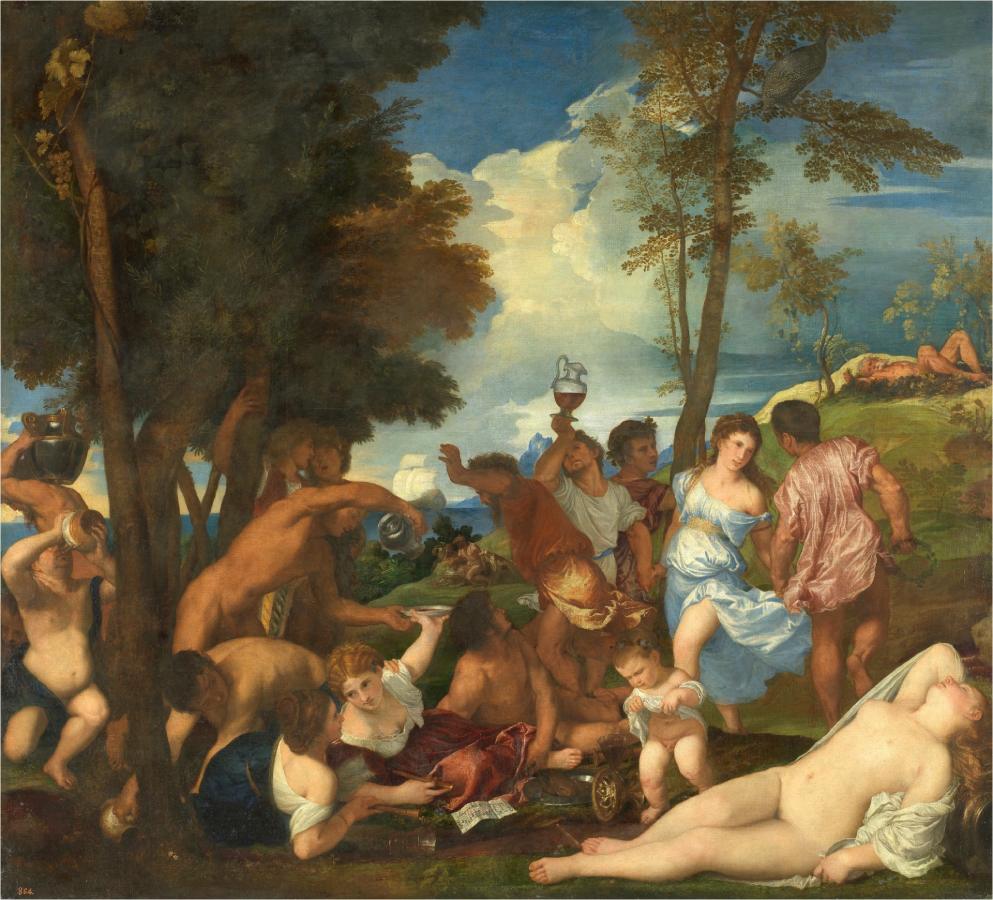Tiziano (c.1488-1576)
Baccanale degli Andrii (Bacchanal of the Andrians)
1523–1526
Oil on canvas, 175 x 193 cm
Museo del Prado, Madrid
Having delivered the Bacchus and Ariadne in 1523 Titian then painted The Andrians, also inspired by Philostratus. The scene is set on the island of Andros, a place so favoured by Bacchus that a stream flows with wine. Gods, men and children unite in the celebration of the effects of wine, whose consumption, in Philostratus’ words, makes men rich, dominant, generous to their friends, handsome and four cubits high. The musical score in the foreground is related to this concept: the canon ‘Chi boyt et ne reboyt il ne seet que boyre soit’ (who drinks and does not drink again does not know what drinking is), is attributed to Adriaen Willaert (about 1480-1567), a Flemish musician in the service of the Ferrarese court. The inclusion of this canon, precedent of the canon per tonos and an attempt to recreate the music of ancient Greece, reveals profound analogies between contemporary musical theory in Ferrara and the chromatic innovations of Titian, whose musical knowledge is also documented.
In comparison to The Worship of Venus (P419), here Titian depends much less closely on his literary source. The artist was more interested in the general sense than in the literal transcription of the narrative and allowed himself certain liberties. The principal one was to leave out Bacchus and his followers whom we must imagine to be on the boat which is leaving and whose absence was justified by Panofsky in that the god makes his appearance in the Bacchus and Ariadne. In the same way, the reduction in the number of children from those mentioned in the text to just one is probably a reaction to their abundance in The Worship of Venus. In the same way, Titian allowed himself to refer to other themes, such as that of The three ages of Man (Panofsky, Gentili, Goffen), and included figures that are not mentioned by Philostratus but which are appropriate to a Bacchic context, such as the nymph asleep in the lower right-hand corner or the urinating boy (a representation of laughter), and others wearing contemporary dress. These artistic liberties have made it difficult to identify some of the figures, particularly the old man who lies exhausted in the background, probably a personification of the river god, as described by Philostratus: The river, seized with great agitation, lies on a bed of branches. The most attractive figure in the composition is the nymph in the right-hand corner, a splendid female nude in which Titian combines vulnerability, sensuality and a suggestion of sexual availability to the spectator. Although this figure cannot be identified as Ariadne, who was abandoned on Naxos and not Andros, her pose, aside from its formal sources, recalls another passage from the Imagines (1, 15:) Look also at Ariadne, observe how she sleeps: nude from the waist up, her neck tilted back to reveal her smooth neck, her right under-arm completely revealed while her other hand is hidden beneath her tunic.
Titian turned to both classical and contemporary sources. Thus, the reclining male figure in the centre derives from Michelangelo‘s Battle of Cascina, while the splendid female nude in the lower right corner evokes the Ariadne known at that period as Cleopatra in the Vatican as well as, and more probably, a Roman sarcophagus known and reproduced by North Italian artists from the fifteenth century. Other figures also look to classical statuary. The maenad dressed in white recalls an antique torso in the Grimani collection (this is more evident in the X-radiograph, where the angle of the neck is identical), while the woman in contemporary dress lying in the foreground probably derives from a funerary relief which entered the Farnese collection in 1548. The urinating boy was also a common motif on classical tombs. Finally, the nude male figure who pours wine on the left seems to be a reworking of the Persian or Wounded Gaul, a Hellenistic sculpture found in Rome in 1514–15 and probably known to Titian through a drawing. He had already made use of this figure for his Saint John the Baptist in the Baptism of Christ (Rome, Pinacoteca Capitolina). However, the freshness of many of these figures indicates the use of life studies. On 14 April 1522 Alfonso d’Este’s agent in Venice told his master that Titian did not wish to leave the city and come to Ferrara as he had prostitutes and men who he could use as nude models. While the date coincides with the production of the Bacchus and Ariadne, it seems logical to think that the artist would continue with such practises later on.
(Falomir, Miguel, Tiziano, Madrid, Museo Nacional del Prado, 2003, p.166)
